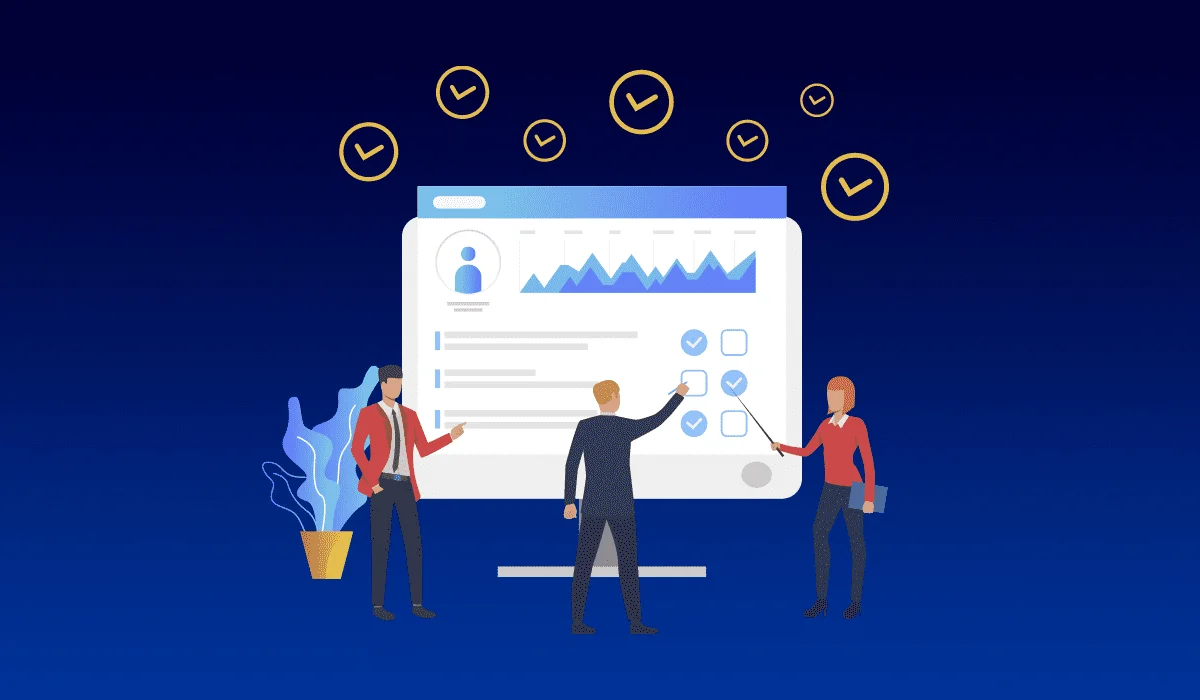Importance of Internal Linking: How it Impacts SEO Performace
Vineeths22 May 2024
Just look around, websites are competing with each other for attention and engagement.
But how will you ensure that visitors will find the information they need and stay interested in your website content?
The answer lies in optimizing your website and using internal linking in the right way!
Internal linking is a powerful technique for your online success.
However, due to many reasons, they are often ignored.
Internal linking can be used to enhance user experience, boost search engine rankings, and establish your online brand authority.
So in this blog, we will try to understand the importance of internal linking and explore its numerous benefits.
But before let’s know the basics!

What’s Ahead
What Is Internal Linking?
Internal linking refers to the practice of creating hyperlinks that connect one page on your website to another page within the same domain.
These links are placed within your content or navigation menus.
They act as signposts or pathways, guiding users through your content and allowing them to navigate from one related topic to another seamlessly.
They also help search engines to find relevant information.
Internal links play a vital role in both user experience and search engine optimization (SEO).
Types of Internal Links
There are several ways to incorporate internal links into your website:
The menu or navigation links are the backbone of your website’s internal linking structure.
These links are typically found at the top or side of your website and serve as the primary means of navigation for users.
They provide access to the main sections or categories of your site, such as the home page, about page, services, blog, and more.
When creating menu links, it’s essential to keep them organized and intuitive.
So make sure to use clear, descriptive labels that accurately represent the content of each section.
Implement a hierarchical structure, with top-level categories and subcategories, to make it easier for the users to drill down to specific topics or pages.
Menu links not only improve user navigation but also play a crucial role in search engine optimization.
Search engines use these links to understand the structure and hierarchy of your website, which can impact how your pages are ranked and displayed in search results.
Footer links are very important while considering ways to enhance your internal linking strategy.
Footer links are typically found at the bottom of each page and can provide additional navigation options for the webpage users.
While footer links may not be as prominent as menu links, they can still significantly impact user experience and SEO.
For example, you can use footer links to highlight important pages or sections of your website that may not fit naturally into the main navigation menu.
This can include links to your privacy policy, terms of service, contact information, or even a sitemap.
Footer links are an excellent way to cross-link between related content or pages that may not be directly connected through the main navigation.
This can help search engines better understand the relationships between different parts of your website and improve the overall visibility of your content.
Sidebar
Sidebar links are another type of internal link that can be highly effective in guiding your webpage users to related content.
Sidebars are typically located on the left or right side of your website’s content area.
They comprise of variety of links, including links to other pages, blog posts, or specific sections of your site.
They can be particularly useful for blog websites or content-heavy sites.
The links can assist users who are interested in exploring related topics or reading more in-depth information on a specific subject.
By incorporating relevant sidebar links, you can improve user experience by providing easy access to additional content.
With sidebar links, you can reinforce the topical relevance of your pages to search engines.
But while using sidebar links, it’s important to ensure that they are well-organized and contextually relevant to the content on each page.
This can help visitors quickly identify and access the information they are looking for.
They also provide valuable signals to search engines about the relationships between your content.
In-text
In-text links, also known as contextual links, are hyperlinked words or phrases within the body of your content.
It helps in directing users to other relevant pages or resources on your website.
These links are often used to provide additional context, support, or elaboration on specific topics or points mentioned in your content.
In-text links can be incredibly effective in improving user engagement and encouraging further exploration of your website’s content.
You have to place these links strategically if you want a seamless flow of information, allowing the readers to explore related topics or access supporting materials easily.
From an SEO perspective, through these links search engines gain a clear understanding of how the pages and subjects on your website link together.
The links guide search engine crawlers and indicate the relevance and context of the linked content.
They also have the additional benefit of adding to the linked pages’ overall link equity and authority.
This can potentially lead to an increase in the visibility and ranking of the linked material in search results.
When using in-text links, it’s important to strike a balance between providing valuable information and avoiding excessive or irrelevant linking.
So always aim to link to pages or resources that genuinely enhance the reader’s understanding or provide additional context to the topic at hand.
Why Internal Link Building?
The importance of internal linking goes beyond simple navigation.
Here’s how a well-crafted internal linking strategy benefits both your users and your website:
Improves User Experience
Internal links can help you guide users to seamlessly navigate through your website’s content.
By providing relevant and contextual links, you can create a smooth browsing experience that allows users to effortlessly explore related topics and information.
This not only enhances their overall satisfaction but also reduces frustration and confusion, leading to a more positive user experience.
When users can easily navigate from one page to another without encountering dead ends or irrelevant content, they are more likely to perceive your website as well-organized and user-friendly.
This sense of ease and intuitive navigation can increase their trust in your brand and encourage them to explore your website further.
Using internal links can reduce bounce rates and attract the attention of potential visitors.
Keeps Users on Your Website Longer
One of the key advantages of using internal linking is its ability to keep users engaged on your website for extended periods.
By strategically linking to related content, you can create a continuous flow of information, making the users delve deeper into your offerings.
Through internal linking, you are encouraging the users to explore further in your website.
It increases the likelihood of them discovering additional products, services, or information that may be of interest to them.
Longer website usage by your users and reduced bounce rates are positive signals for search engines, indicating that your website provides valuable and engaging content.
This can positively impact your search engine rankings and overall online visibility.
Help Readers Learn More in Blog Posts
For content-heavy websites like blogs, internal linking plays a crucial role in enhancing the reader’s learning experience.
By including internal links within your blog posts, you offer readers the opportunity to expand their knowledge on specific topics or gain additional insights.
If you find any complex concept that requires further explanation, you can easily link your page to another blog post or any other relevant resource about the content.
This will not only help the readers but also help you in highlighting the scope of your content.
The internal links can also help the readers to take to related articles or resources they may have missed.
Yes! Internal links are that important!
It can easily convert a mere click into a potential customer.
So make it a practice to note down the relevant links that can be added as internal links while preparing content.
Seo Benefits of Internal Linking
The importance of internal linking is not just enhancing user experience, it is much more.
It plays a crucial role in Search Engine Optimization (SEO).
Let’s check out some SEO advantages of internal linking:
Easier for Google to Crawl and Discover New Pages
Search engines heavily rely on internal links to discover and crawl new pages on websites.
As mentioned they act as virtual pathways, guiding search engine crawlers through your site’s structure and enabling them to find and index new pages more efficiently.
Without proper internal linking, search engines may struggle to locate and crawl all the pages on your website.
It can potentially lead to some valuable content being ignored or not indexed correctly.
By implementing a well-structured internal linking strategy, you make it easier for search engines to navigate and discover every corner of your site.
Signal Relevance and Context
The internal links don’t just help search engines find your pages; they also provide valuable context and relevance signals.
When you link related content together, you’re essentially telling search engines that those pages are topically connected and relevant to each other.
This information can help search engines get a better understanding of the relationships between different pieces of content on your site.
And this can influence how they interpret and rank those pages for relevant queries.
By strategically incorporating internal links that connect related topics and concepts, you enhance the topical focus and relevance of your content.
This approach has the potential to increase visibility in search results.
Distribute PageRank
In the SEO, PageRank is a metric used by Google to measure the importance and authority of a web page.
Internal links play a crucial role in distributing this valuable PageRank (also known as link equity) across your website.
When you link from one page to another, you’re essentially passing along a part of that page’s PageRank to the linked page.
By strategically linking to your most important and authoritative pages, you can help boost their PageRank and increase their chances of ranking higher in search results.
This process of distributing PageRank through internal links is a good technique for optimizing your site’s architecture and authority in specific topic areas.
Help Google Understand Your Authority on a Topic
Building a strong internal linking structure around key topics or themes can help you demonstrate your expertise and authority in those areas to search engines.
When Google sees a dense network of high-quality, interlinked content on a particular subject, it perceives your website as an authoritative source on that topic.
This can help you in ranking, as search engines aim to provide users with the most relevant and trustworthy information for their queries.
By consistently linking related content and reinforcing your topical focus, you can easily establish your webpage as a trusted source of information.
This can boost your webpage’s visibility and rankings for relevant keywords and topics.
Build Your Link Equity
Internal linking is not only useful for search engines but it is an important tool for building and distributing link equity throughout your website.
Link equity refers to the cumulative value and authority that a page accumulates from incoming links, both internal and external.
By linking your most important pages from various other parts of your site, you can concentrate and amplify the link equity flowing to those pages.
This can help you in gaining followers to your product pages, or other high-priority pages on your website.
Conclusion
By now you might’ve understood the importance of internal linking.
By strategically connecting your website’s content, you create a user-friendly experience, keep visitors engaged, and signal value to search engines.
By implementing a well-thought-out internal linking strategy, you can make your website a powerful and effective medium for sharing relevant information.
So, take advantage of the power of internal linking and make your website a success!
Since you have stayed so far why don’t you check out our related articles as well?
- The Ultimate Guide to On-Page SEO Optimization
- Why Image Optimization Matters for SEO
- 5 Tips to Optimize Your Website to Be Mobile Friendly
- Tips to Optimize Your Website for Google Mobile-First Indexing
- The Role of URL Optimization in Improving Website Ranking
- Mastering Header Tags to Boost Your Website’s Readability and SEO
Latest Post

5 Do’s and Don’ts When It Comes To SEO
 18 Sep 2023
Readmore
18 Sep 2023
Readmore
Want to learn more about the digital marketing service we provide?
Contact Us to Get Started!




